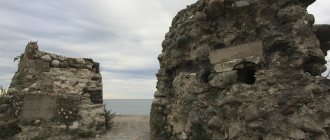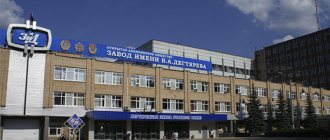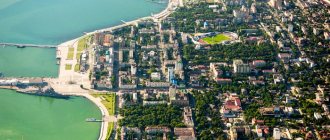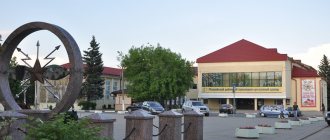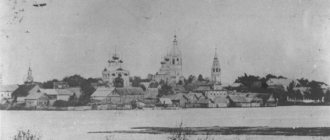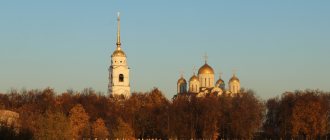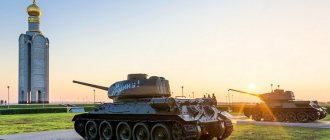The visiting card of Sukhum is the monkey nursery
Sukhum in Soviet times was called Sukhumi. And even earlier the city bore the names Dioskurias, Sebastopolis, Tskhum, Sukhum-Kale. This diversity speaks to its long history. Indeed, the city existed back in the days when the Egyptian pharaohs built their pyramids. In Sukhum, such ancient buildings have not been preserved, but there are other extraordinary attractions that attract tourists.
On the shore of Sukhumi Bay
Sukhum is the capital of Abkhazia. The city is located on the Black Sea coast in Sukhumi Bay. The distance from the Russian border is 107 kilometers, from Sochi - 146 kilometers. The Sukhumka and Basla rivers flow from the mountains through the city. On the southern side it is bordered by the Kyalasur River. From the north, the Main Caucasus Range rises like an impregnable wall. In a straight line, from Sukhum it is a stone's throw to the Russian mountain resorts of Arkhyz and Dombay. The population of the city does not exceed 70 thousand people.
The city is located on the shore of a large bay
As on the entire coast, the climate in the city is humid subtropical. This is eloquently confirmed by the large number of palm trees. In winter, the air temperature ranges from +6 to +8 degrees. In summer, temperatures range from +24 to +30 degrees. The warm period is characterized by high humidity. The best time for excursions and hikes is April, May, September. It is better to come for swimming closer to mid-June. Sea water warms up to 28 degrees.
Entertainment in Sukhumi
Holidays in Sukhumi mean beaches, sun, excursions and entertainment. In addition to beach attractions, diving clubs, rafting, rock climbing and canyoning, the city has several entertainment centers. Let's take a look at the first one we come across, located on the embankment. A three-story modern building in which peacefully coexist:
- bowling alley;
- large bar-restaurant;
- lounge for large groups.
Guests can order European dishes, snacks, alcoholic drinks and cocktails here. The average restaurant bill is 400-500 rubles. In other centers, conditions of rest and service are approximately the same.
Competitor to Rome and Istanbul
Archaeological finds on the territory of the modern city indicate that people lived here 300 thousand years ago! Scientists call this period the Lower Paleolithic. It dates back to the ancient Stone Age. The history of the city itself goes back 2,500 years. Rome, Syracuse, and Istanbul can boast of this age.
In the Sixth century BC, the Greeks settled on the seashore at the foot of three mountains. They founded the colony of Dioscuria, naming it in honor of the Dioscuri brothers, who were participants in the Argonauts' campaign to Colchis. The settlement played the role of a transit point for trade with the North Caucasus, where about 70 peoples lived.
Archaeological finds
The Greeks were replaced by the Romans, who built the fortress of Sebastopolis. Its walls stood for almost two centuries. Subsequently, the fortress was captured by the Byzantines. Under them, the city flourished until the Arabs attacked. They were unable to gain a foothold on the coast, but managed to pretty much destroy the city. In 736 the settlement was known as Tskhum. Then it was part of the Abkhazian kingdom, which later came under Georgian jurisdiction.
After a century of calm, the Genoese moved to the coast. Under them, the city became an important port. However, in the 16th century the Turks were already in charge here. Having captured the city, they renamed it Sukhum-Kale. Only at the end of the 18th century did the Abkhazians manage to recapture the fortress. The Prince of Abkhazia moved his residence here. In 1810, an agreement was signed on the entry of Abkhazia into Russia.
Even souvenirs testify to the ancient age of the city
In the 19th century, Sukhum became a popular seaside and medical resort. In 1861, Emperor Alexander II came here on board the yacht Livadia. After the revolution, the resort was chosen by the creative intelligentsia. Chekhov, Paustovsky, Gorky, Yesenin rested here. Sukhum was recognized as the best resort for the treatment of pulmonary diseases. Treatment was successfully combined with entertainment. Restaurants “Paris”, “Birzha”, and the confectionery “Hollandia” appeared in the city. The name Sukhumi has become synonymous with a beautiful life.
The parliament building was damaged during the Georgian-Abkhaz war
The resort was a popular holiday destination before the Georgian-Abkhaz conflict, which occurred in the early 90s. The city was badly damaged during the fighting. Many sanatoriums, hotels, and holiday homes were destroyed. After the war, the population of the republic was reduced by half. The number of residents of the capital has also decreased. Only in 1994 was a truce signed. Tourists actively traveled to the republic at the end of the 2000s.
We walk around the center
As befits a seaside city, Sukhum has a promenade. The hallmark of the embankment is the majestic colonnade. In the center there is an arch that serves as a passage to the sea. A monumental structure in a neoclassical style appeared on the shore in 1948. From here you can clearly see the Sukhumi port.
Now this is the Makhadzhirov embankment, and at the beginning of the last century it was Mikhailovskaya. Three times a week a military brass band played on the shore. Guidebooks of that time claim that it was all dotted with coffee shops and restaurants. The tables were right on the sidewalks under the palm trees. Behind them sat groups of men playing chess, backgammon and dominoes. The most amazing thing is that the same picture can be seen now! Everything changes except people's habits.
This picture could have been seen on the embankment 100 years ago.
Coffee shop No. 1, popularly nicknamed “Brekhalovka,” was extremely popular. Politicians and businessmen gathered here. Deals were made over a cup of coffee. Women didn't come here. The cafe with the same name is still operating today! It is located near the colonnade. But women are no longer prohibited from entering.
After a walk along the embankment and a visit to a coffee shop, you can get to know the city center. Fortunately, all iconic places are located within walking distance. Directly behind the colonnade is Theater Square, which houses three temples of art - the Drama Theater named after. S. Chanba, Russian Drama Theater and Art Gallery.
Sculptural composition near the Drama Theater
On Teatralnaya Square your attention will certainly be attracted by an unusual fountain. Adjacent to the drama theater is the ancient building of the Ritsa Hotel, built in 1914. From an architectural point of view, the building of the ancient Oriental Hotel is also interesting. It is located on Leon Avenue, opposite Ritsa.
To the right of the Drama Theater is the government quarter. It includes the Presidential Administration and the Cabinet of Ministers. The building is surrounded on three sides by green areas. On the left is the park named after. B. Shinkuba, in which there is a monument to the national poet Bagrat Shinkuba. The park also contains the buildings of the Academy of Sciences and the Folk Song and Dance Ensemble of Abkhazia. On the right is a square with a monument to victims of political repression. The government fences off the Eucalyptus Park from the sea, where a monument to the Mukhajirs is erected - this is the name given to the victims of the Caucasian War of the 19th century.
Leon Avenue
It is worth taking a walk along the Mahadzhirov embankment towards the port. Along the way you will see several funny sculptures - “Old Tachkum”, “Nika”, “Chick and the Chicken”, “Penguin Philosopher”. You can tell from their shiny noses that they serve as talismans. All you have to do is make a wish and rub your nose. They also leave a coin for the penguin on the table. The traditional location for a photo shoot is the “YeSUKHUM” composition. It is installed in the background of the port.
The 37-meter-high Sukhumi Lighthouse is considered an engineering landmark. In 1861, it was made in France, transported to Sukhum and installed on a cape jutting out into the sea. It took 150 days to assemble the giant. A spiral staircase with 137 steps leads upstairs. The lighthouse has been operating for almost 160 years!
Beaches of Sukhumi
Beach holidays in Sukhumi include a selection of beaches stretching along a 10-kilometer strip along the sea. Among these beaches there are many wild ones, but there are also equipped areas. There are several main beaches in Sukhumi. The most visited of them:
- "Central city beach". Free. Length about 2 km, width - 50 m. Pebble, sandy in places. Equipped with breakwaters. On the back line there are cafes and restaurants. There are many attractions on the "Central City Beach".
- "MVO" and "Strategic Missile Forces". The beaches of the sanatoriums of the same name are located on their territories. They border each other conditionally, really representing one large beach. Length - 2.5 km, width - 15 m. These pebble-sand beaches are the most equipped among all Sukhumi beaches (umbrellas, changing cabins, sun loungers, toilets and showers). They boast a full complement of standard attractions (including parachutes). There are special courts for beach volleyball fans. Entrance to these beaches is paid and according to lists.
- "Agudzersky Beach". It is located not far from Meditsinsky. The length of the beach is 1 km, width is only 8 m. It consists of sand and pebbles, the bottom has a sharp slope. The beach is minimally equipped - changing cabins, several cafes, a canteen. The sparseness and beauty of Agudzero Beach forgive this “flaw”, and some townspeople rest only on it.
- "Sinop (Medical) Beach." Located in the western part of Sukhumi, near the MVO and Strategic Missile Forces beaches. The length is about 2 km, the width reaches 20 m. “Medical Beach” is sandy, almost without stones. Equipped with umbrellas and sun loungers. Among the coastal entertainments you can find here: “banana”, jet ski, boat and yacht trips, sports grounds, cafe-bar, disco, restaurant “Aitar”. “Medical Beach” is one of the most beautiful beaches in Abkhazia. For those who want to spend their holidays in Sukhumi on this beach, there is good news: next to it there is the Aitar hotel and a cottage community. There are areas on the “Medical Beach” that nudists have chosen for their vacation.
- "Dolphinarium (Mayaksky Beach)." Located in the northern part of Sukhumi, 4 km from the “Central Beach”. The length of the beach is 3 km, width is 10-15 m. The beach is sand and pebbles, sandy in places. The bottom is flat, with small pebbles. The shore is “equipped” with catering establishments (bars, cafes, beer outlets, food stalls). Not far from the “Mayaksky Beach” the Gumista River flows into the Black Sea. Previously, dolphins loved to frolic in this place, thanks to which the beach received its unofficial name - “Dolphinarium”. Unfortunately, today not everyone will be lucky enough to see a dolphin near this beach...
Milestones of history
Despite its advanced age, almost no ancient buildings have survived in Sukhum. To get an idea of the city's distant past, you can visit the Abkhaz State Museum. It is located 150 meters from the famous Sukhumi Botanical Garden. The museum opened in 1917 and today has a collection of 100 thousand items. Some exhibits have world value. There are rarities that are 50 million years old! In the park near the museum you can see a real dolmen.
Dolmen
Near the port on the seashore, fragments of the walls of a medieval fortress have been preserved. Once their thickness reached two meters. Inside there were houses for officers, a church and even a marble fountain. The citadel was destroyed during the Russian-Turkish war. The buildings were looted, and the Turks took the entire fountain away. At the beginning of the 20th century, the fortress was used as a prison. Revolutionary Sergo Ordzhonikidze served his sentence here. Now all that remains of the fortress are ruins.
Another evidence of the ancient age of Sukhum is Bagrat Castle, which formerly bore the name Akua. The ruins of stone walls rise on a mountain in the northeastern part of the city. It was erected in the 10th century. In plan, the building had the shape of an ellipse. The castle stands on the edge of a cliff, which served as a natural defense against attack. The height of the walls reached 12 meters, and the width reached two. The fortress protected the approaches to the southern part of the Abkhazian kingdom. On the territory of the castle, archaeologists found many ancient artifacts - coins, jewelry, dishes.
Ancient water conduit
Like China, Abkhazia has its own Great Wall. The stone fortress stretches 160 kilometers from the Kelasur River to the mouth of the Inguri River! There were several hundred towers on it alone. Each tower was up to 12 meters high and was a mini-fortress. The wall was most likely built by the Persians in the second half of the Sixth Century. Nowadays, rare ruins remain from the grandiose fortification structure. Fragments of an ancient tower can be seen five kilometers from Sukhum, near the mouth of the Kelasur River.
The Besletsky Bridge is worthy of attention. It is also called the Queen Tamara Bridge. The stone arch over the Baslu River near Sukhum was erected in the 11th century. Her age is about a thousand years! The length of the unusual engineering structure reaches 35 meters. The road from the sea to the mountains went through the bridge. It was of strategic importance and was under 24-hour security. On the shore there are ruins of a watchtower. Despite its external fragility, the bridge can still bear a load of up to eight tons! Behind it begins a picturesque river gorge, rich in beautiful places.
Past and present
To get an idea of the modern history of Abkhazia, it is worth visiting the Museum of Military Glory named after Vladislav Ardzinba, the first president of the republic. It was opened in 2014 and is dedicated to the Lat tragedy. The exhibition tells about the events of the 1992-1993 war. One room is dedicated to the Great Patriotic War. The Glory Park serves as a unique addition to the museum exhibition. It is located in the city center between Aiaaira Avenue and Lakoba Street.
Attractions Sukhum
- Dioskouri Embankment;
- 18th century lighthouse;
- Beslet arch bridge;
- Remains of the Roman fortress of Sebastopolis;
- Mahajirov Embankment;
- Botanical Garden, founded in 1840;
- Arboretum;
- Bagrat Castle;
- Marheul mini-spring;
- Queen Tamara Bridge;
- Park of Glory;
- Theatre square;
- State Drama Theater of Abkhazia;
- Fountain-cascade with griffins;
- Apery.
Sukhum is a balneological resort in Abkhazia.
Recently, the tourism infrastructure of Suhama has been gaining momentum again: old hotels and resort complexes are being restored and new ones are being built to accommodate the growing flow of tourists.
Apery
One of the calling cards of the city is undoubtedly the Sukhumi monkey nursery. A purely scientific institution appeared on Mount Trapezia, on the territory of the former dacha of Professor Ostroumov, in 1927. The idea of the nursery belongs to the Soviet People's Commissar of Health Semashko. Primates were needed to study human diseases and test drugs. The place was chosen for a reason. Firstly, the climate was suitable for the monkeys, and secondly, they had fruits and vegetables at their disposal all year round.
Monument to the hamadryas baboon
The first residents of the nursery were two pairs of baboons and chimpanzees. They were delivered by ship from Guinea. In 1928, the first baby hamadryas was born. In the 30s, there were already about a hundred primates of different species. On the basis of the nursery, the Research Institute of Experimental Pathology and Therapy was created, in which famous Soviet scientists worked. It soon became a center for the fight against cancer of international importance.
In the 60s, the institute’s “staff” included about a thousand primates. Twelve macaques were being trained to fly into space. A special spacecraft “Bion” was designed for them. With the help of monkeys, more than 5 thousand scientific studies were carried out, the first models of viruses were created and various vaccines and medicines were developed. The Georgian-Abkhaz war made big adjustments to the life of the nursery. By the end of the fighting, about 90 monkeys remained here.
It is not prohibited to feed animals
Fortunately, life began to improve, and now the nursery contains about 500 monkeys of seven species, including green monkeys, lapponder macaques, anubis baboons and hamadryas. The uniqueness of the scientific institution is that everyone can freely visit the nursery.
Upon entering, visitors are greeted by the world's only monument to the hamadryas baboon, erected in 1977 for services to the field of medicine. The pedestal lists diseases that were overcome thanks to primates. Monkeys are kept in outdoor enclosures. You can watch them for hours. Feeding animals is not prohibited. Bags of food can be purchased at the box office along with your ticket.
Botanical Garden
The second calling card of Sukhum is the Botanical Garden. It appeared on the coast in 1838. At that time there was a Russian military garrison in the city. The doctor Bagrinovsky, who was fond of growing plants, built a small garden near his house. An unusual hobby attracted the attention of Lieutenant General Raevsky, who served as head of the fortified area. He decided to take over the garden for government maintenance. This required permission from Emperor Nicholas I.
The botanical garden is located in the center of Sukhum
Thus, the private garden turned into a government institution called the Sukhum-Kal Military Botanical Garden. After this, the planting area was significantly increased. A tea bush, lemon and orange trees were brought from the Crimean Nikitsky Botanical Garden. The tea bush turned out to be a long-liver - it lived for more than a hundred years! In addition to exotics, traditional fruits and vegetables were grown. They went into the officers' rations.
Guests from America
The garden changed significantly when the famous gardener P. Tatarinov was appointed its director in 1894. He founded an experimental station in Sukhum and went to South America, from where he brought seeds of dozens of species of agaves, palm trees and other subtropical plants. After this, the Sukhumi garrison “vegetable garden” turned into a classic botanical garden. Here you could see plants from different parts of the planet.
Bamboo Grove
During the Soviet period, more than 5 thousand species of plants grew in the garden! The pride was the magnificent collection of palm trees. The attention of visitors was invariably attracted by the Rose of Banks vine, which, like a snake, wrapped itself around the trunk of a palm tree, rising to a height of 30 meters. The collection of magnolias had a great effect on visitors. The botanical garden was badly damaged during the Georgian-Abkhaz conflict. Hundreds of shells exploded across the park.
The age of the linden tree has exceeded 350 years
Now the Botanical Garden has been put in order. Tourists specially come to see with their own eyes the linden tree, whose age has exceeded 350 years. She was born when there was no garden yet! The Turks tried to cut down the tree; a hurricane almost broke it, but the linden survived. The diameter of its trunk exceeds three meters! The bamboo grove and old sequoia, which were planted in the garden in 1848, are very beautiful. There is a Peace Tree in the park. He was imprisoned in 2010 as a sign of friendship between Abkhazia and Russia.
Optional
Sukhum can be called the cultural capital of Abkhazia. Local residents will certainly recommend you to visit the Gulia House Museum. It is located on Gulia Street near Freedom Park. Abkhazians consider Dmitry and George Gulia to be their Cyril and Methodius. The first gave writing and opened a mobile theater on carts. The second is considered the patriarch of Abkhaz literature. There is a monument to Dmitry Gulia in Sukhum.
Monument to Dmitry Gulia
There are several temples in the city. The main Orthodox shrine is the Annunciation Cathedral. It was built just before the revolution and consecrated in 1915 in honor of St. Nicholas the Wonderworker. Later it was consecrated in honor of the Annunciation of the Blessed Virgin Mary, leaving the chapel of St. Nicholas. Until 1990, the tomb of John Chrysostom was kept in the cathedral. Then she was transferred to a monastery in the village of Koman near Sukhum. The capital is home to one of two mosques that operate in Abkhazia.
Memory of Abkhazia
If time permits, it is worth visiting the sulfur thermal springs. They are located five kilometers from the Red Bridge on the road to the Besletsky Bridge. Even the ancient Romans built baths and baths here. They were designated on maps as “Happy Springs.” In Soviet times, there was a balneological hospital here. It was destroyed during the war.
Food in Sukhumi
Many tourists going on vacation to Sukhumi are concerned about the issue of catering: where are the products cheaper, and where is the food tastier and safer? Among other resorts in Abkhazia, Sukhumi catering is a leader in the “price-quality” category. And yet, when choosing a cafe or restaurant, pay attention to the presence of local residents at the tables. A little Abkhazian trick: if Abkhazians go to a cafe, it means the food there is really good! In most restaurants in Sukhumi, a tip (approximately 10% of the total) is included in the bill. Where to eat in Sukhumi? The best cafes and restaurants located on the central embankment:
- "Elbrus". The restaurant is located on the Dioskouri Embankment. On the same territory guests are treated to a restaurant, cafe and apatsha (national restaurant). Open all year round, offering set lunches and delicacies of Abkhazian and European cuisine. In the summer, discos are held at Elbrus every evening. The prices in the restaurant are average for Sukhumi, and in the cafe they are slightly lower than in the restaurant. There are trampolines for children near the cafe.
- "Apra." Restaurant, stylized as a ship. Located “almost in the Black Sea” - at the end of the pier. From the windows of the restaurant there is a beautiful panorama of Sukhumi Bay. At Apre you can order dishes of Japanese, European and Caucasian cuisines. Light music (jazz, relaxation, blues), average prices for the city. Nice bar, huge selection of cocktails.
- "At Hakob's." The cafe, better known as “Brekhalovka”, is a real landmark of Sukhumi. Located opposite the Ritsa Hotel. Regular visitors are local men. There is a homely atmosphere here: they drink coffee, play chess or dominoes, and... gossip. In Sukhumi they say: “Hurry to “Brekhalovka” - it is here, over a morning cup of coffee, that ministers and presidents are removed and appointed.”
Gastronomic “pearls” of Lakoba Street:
- "At Robik's." Famous cheburek. Modest surroundings, clean, cheap and tasty. The sign says: “Robik’s chebureks are just like mom’s.”
- "Adu and Company" Cafe-snack bar. Home cooking, low prices. Signature pizza is the pride of this cafe.
Prospekt Mira invites you to visit:
- An inexpensive canteen located across the street from the telephone meeting point.
- "Old Sukhum". Cafe-veranda. You can also book a table here for New Year.
- Not far from Mira Avenue there is the Olimpia Club, an entertainment center. A café and bar, slot machines, a dance floor, bowling alley, and billiards found shelter within its walls.
In general, cafes and restaurants in the capital of Abkhazia are the topic of a separate, large article. You could say monographs. Therefore, in our review we will focus on “what has been achieved”, summing up: the city’s catering is diverse and versatile, and a walk through the local cafes is an excursion in itself. Are you going on holiday to Sukhumi? Bon appetit!
How to get there
The closest airport to Sukhumi is in Sochi (Adler). From the airport, take public transport to the Psou checkpoint (about 10 kilometers) and cross the border. Russians can do this with an internal passport. On the Abkhaz side, tourists will find regular buses and minibuses that take tourists along the entire coast, including to Sukhum. You can use a taxi.
You can take a taxi from the border to Sukhum
In summer, trains run directly from major Russian cities to Sukhum. The railway station is located on the outskirts of the Abkhaz capital. An international bus service has been organized between Sukhum and Moscow, as well as the southern cities of Russia. In summer, bus tours to Abkhazia are offered by tour operators. You can enter Abkhazia by car only through the Psou checkpoint.
